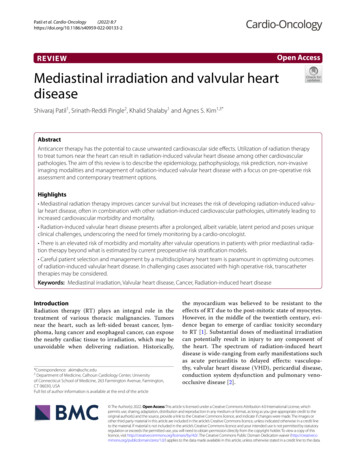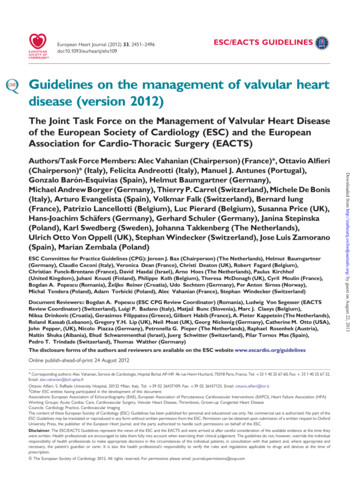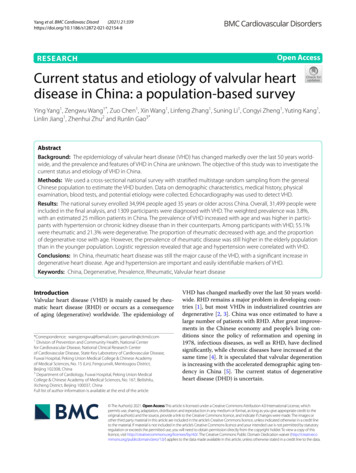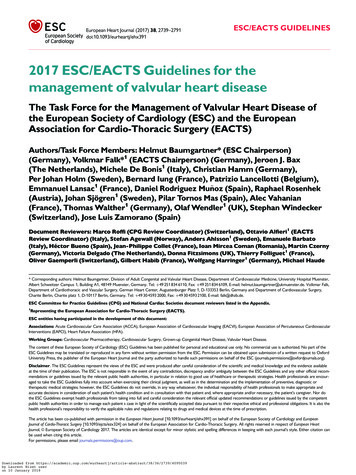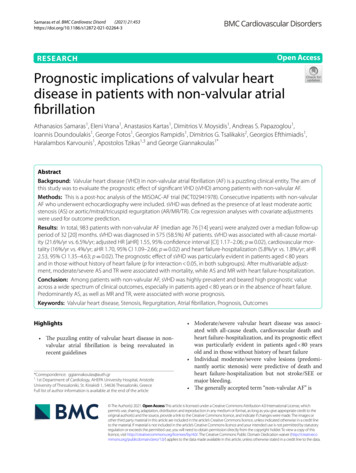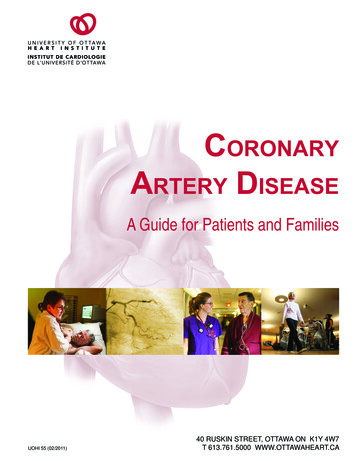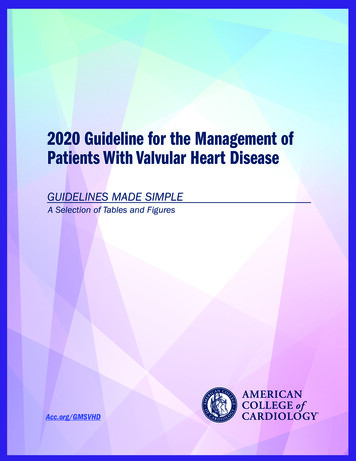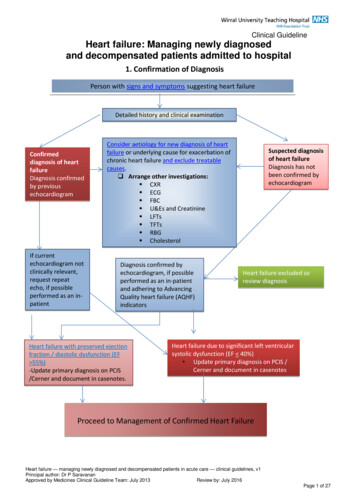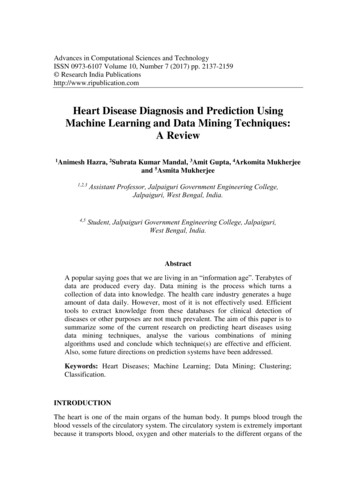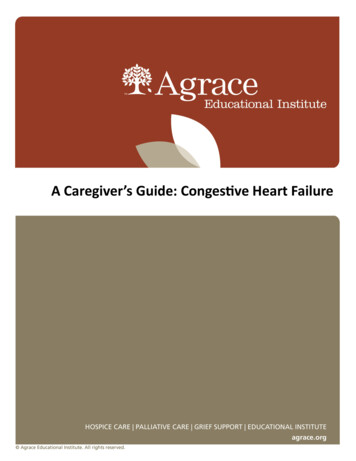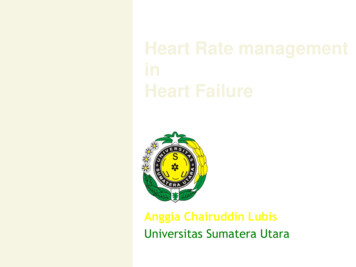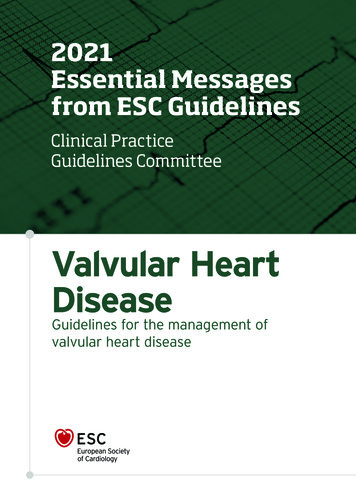
Transcription
2021Essential Messagesfrom ESC GuidelinesClinical PracticeGuidelines CommitteeValvular HeartDiseaseGuidelines for the management ofvalvular heart disease
Essential Messages2021 Essential Messages from the ESC/EACTS Guidelines forthe management of valvular heart disease*Developed by the Task Force for the management of valvular heart disease of the European Society ofCardiology (ESC) and the European Association for Cardio-Thoracic Surgery (EACTS)ESC ChairpersonEACTS ChairpersonAlec VahanianUFR Medecine,Université de Paris, site Bichat& LVTS INSERM U1148, GH Bichat75018 Paris, FranceTel: 33 6 63 15 56 68E-mail: alec.vahanian@gmail.comFriedhelm BeyersdorfDepartment of Cardiovascular Surgery,University Heart Centre, University Hospital Freiburg& Medical Faculty of the Albert-Ludwigs-UniversityD-79106 Freiburg, GermanyTel: 49 761 270 28180E-mail: friedhelm.beyersdorf@uniklinik-freiburg.deTask Force MembersFabien Praz (ESC Task Force Coordinator) (Switzerland), Milan Milojevic1 (EACTS Task Force Coordinator)(Serbia), Stephan Baldus (Germany), Johann Bauersachs (Germany), Davide Capodanno (Italy), LenardConradi1 (Germany), Michele De Bonis1 (Italy), Ruggero De Paulis1 (Italy), Victoria Delgado (Netherlands),Nick Freemantle1 (United Kingdom), Martine Gilard (France), Kristina H. Haugaa (Norway), AndersJeppsson1 (Sweden), Peter Jüni (Canada), Luc Pierard (Belgium), Bernard D. Prendergast (UnitedKingdom), J. Rafael Sádaba1 (Spain), Christophe Tribouilloy (France), Wojtek Wojakowski (Poland).1Representing the European Association for Cardio-Thoracic Surgery (EACTS)ESC subspecialty communities having participated in the development of this documentAssociations: Association for Acute CardioVascular Care (ACVC), European Association of CardiovascularImaging (EACVI), European Association of Percutaneous Cardiovascular Interventions (EAPCI), EuropeanHeart Rhythm Association (EHRA), Heart Failure Association (HFA).Councils: Council on Valvular Heart Disease.Working Groups: Cardiovascular Surgery, Thrombosis.Patient Forum*Adapted from the “2021 ESC/EACTS Guidelines for the management of valvular heart disease” (European HeartJournal; 2021 - doi: 10.1093/eurheartj/ehab395 and European Journal of Cardio-Thoracic Surgery; 2021 - doi: 10.1093/ejcts/ezab389).
ESSENTIAL MESSAGES FROMTHE 2021 ESC/EACTS GUIDELINESFOR THE MANAGEMENTOF VALVULAR HEART DISEASETable of contentsSection 1 - Key messagesSection 2 - Main gaps in evidence and areas forfuture researchEuropean Heart Journal 2021; - doi/10.1093/eurheartj/ehab395 EuropeanJournal of Cardio-Thoracic Surgery 2021; - doi: 10.1093/ejcts/ezab389
Key messagesGeneral comments1.Precise evaluation of the patient’s history and symptomatic status, as well as properphysical examination, are crucial for the diagnosis and management of VHD.2. Echocardiography is the key technique to diagnose VHD and assess its severity andprognosis. Other non-invasive investigations such as CMR, CCT, fluoroscopy, andbiomarkers provide important additional information in selected patients. Stresstesting should be widely used in asymptomatic patients. Invasive investigation, beyondpreoperative coronary angiography, is restricted to situations where non-invasiveevaluation is inconclusive.3. Decision making in elderly patients requires the integration of multiple parameters,including estimation of life expectancy and anticipated quality of life, evaluation ofcomorbidities, and general condition (including frailty).4. Decision making in asymptomatic patients weighs the risk of intervention against theexpected natural history of VHD. Stress testing should be liberally performed.5. Informed patient’s expectations and values are an important part of the decision-makingprocess.6. Interventions (surgery or transcatheter) are indicated in symptomatic patients(spontaneous or exercise induced) in the absence of futility. In selected asymptomaticpatients, presence of predictors of rapid symptom progression justifies early interventionwhen procedural risk is low.7. Heart Valve Centres with multidisciplinary Heart Teams, Heart Valve Clinics, comprehensiveequipment, and sufficient volumes of procedures are required to deliver high-quality careand provide adequate training.8. Careful follow-up of symptomatic status, LV/RV size, and function is mandatory inasymptomatic patients with severe VHD if an intervention is not yet indicated.9. In patients with AF, NOACs are contraindicated in patients with clinically significant mitralstenosis or mechanical valves. For stroke prevention in patients who are eligible forOAC,NOACs are recommended in preference to VKAs in patients with aortic stenosis, aorticand mitral regurgitation, or aortic bioprostheses 3 months after implantation.Aortic regurgitation10. The evaluation of aortic regurgitation requires careful assessment of potentially associatedaortic dilatation to guide the timing and type of surgery. ACE-I/ARNI, beta-blockers, andMRA may be considered in patients with HFmrEF.ESSENTIAL MESSAGES FROM THE 2021 ESC/EACTS GUIDELINES FOR THE MANAGEMENT OF VALVULAR HEART DISEASE
Key messagesAortic stenosis11. Diagnosis of severe aortic stenosis requires integrative evaluation of pressure gradients(the most robust measurements), AVA, extent of valve calcification, flow conditions, andLV function.12. Selection of the most appropriate mode of intervention by the Heart Team shouldtake into account clinical characteristics (age and estimated life expectancy, generalcondition), anatomical characteristics, the relative risks of SAVR and TAVI, the feasibilityof transfemoral TAVI, local experience and outcome data, as well as informed patientpreference.Mitral regurgitation13. Regarding imaging, routine quantification of EROA is an important part of theintegrative evaluation for quantification and risk stratification in patients with PMR.3D transoesophageal echocardiography is more accurate than 2D echocardiographyfor defining the underlying mechanism of PMR. CMR is useful when echocardiographicevaluation of severe PMR grade is inconclusive.14. Surgical mitral valve repair is the preferred method of treatment in PMR if a durable repaircan be achieved. TEER is a safe but less efficacious alternative that may be considered inpatients with contraindications for surgery or high operative risk.15. In patients with severe SMR, GDMT (including CRT if indicated) should be the first step.If the patient remains symptomatic: mitral surgery is recommended concomitantly inpatients with an indication for CABG or other cardiac surgery. Isolated valve surgery maybe considered in selected patients. TEER should be considered in patients not eligiblefor surgery and fulfilling criteria indicating an increased chance of responding to thetreatment. Circulatory support devices, cardiac transplantation, or palliative care shouldbe considered as an alternative in patients with end-stage LV and/or RV failure.Mitral stenosis16. PMC is currently the standard of care in patients with severe rheumatic mitral stenosisand favourable valve anatomy.17. Decision making as to the type of intervention used in patients with unfavourable anatomyis still a matter of debate and must take into account the multifactorial nature of predictingthe results of PMC.ESSENTIAL MESSAGES FROM THE 2021 ESC/EACTS GUIDELINES FOR THE MANAGEMENT OF VALVULAR HEART DISEASE
Key messagesTricuspid regurgitation18. Relevant tricuspid regurgitation requires early intervention to avoid secondary damageof the RV.19. Tricuspid regurgitation should be liberally treated at the time of left-sided valve surgery.Isolated surgery of severe secondary tricuspid regurgitation (with or without previousleft-sided valve surgery) requires comprehensive assessment of the underlying disease,pulmonary haemodynamics, and RV function.Prosthetic valves20. The choice between a mechanical prosthesis and a bioprosthesis should be patientcentred and multifactorial based on patient characteristics, the indication for lifelonganticoagulation, the potential and risks of a re-intervention, and the informed patientpreference.21. Clinical assessment of prosthetic valves should be performed yearly and as soon aspossible if new cardiac symptoms occur.ESSENTIAL MESSAGES FROM THE 2021 ESC/EACTS GUIDELINES FOR THE MANAGEMENT OF VALVULAR HEART DISEASE
Main gaps in evidence and areasfor future researchGeneral comments1.Prognostic value of CMR-derived indices in patients with aortic regurgitation, aorticstenosis, and mitral regurgitation.2. Tools for risk stratification for the decision for intervention (including the avoidance offutile interventions) and the choice of the type of intervention (TAVI vs. SAVR for aorticstenosis, repair vs. replacement for mitral and aortic regurgitation).3. In asymptomatic patients with aortic regurgitation, aortic stenosis, and mitral regurgitation,identification and evaluation of earlier markers of LV dysfunction (biomarkers, imaging,multimodality) as well as longitudinal and translational studies on progression.4. Gender issues regarding pathophysiology, indications, and timing of treatment.5. Minimum volumes of procedures that are required to achieve optimal results ofintervention.6. Safety and efficacy of NOACs in patients with surgical or transcatheter bioprostheses inthe first 3 months after implantation.7. Patient education for shared decision making and timely evaluation.8. Systematic epidemiological data addressing the burden of rheumatic heart disease.9. Advocacy of VHD.Aortic regurgitation10. Potential differences in the risk of aortic complications depending on subtypes of aorticaneurysms (site and morphology), as well as in patients with bicuspid aortic valves.11. Further evaluation of surgical aortic valve repair.ESSENTIAL MESSAGES FROM THE 2021 ESC/EACTS GUIDELINES FOR THE MANAGEMENT OF VALVULAR HEART DISEASE
Gaps in evidenceAortic stenosis12. Pathophysiology of progression and novel therapeutic targets for medical treatment.13. Further research to evaluate the role of intervention:i.ii.iii.iv.v.Long-term durability of transcatheter heart valves in comparison with surgicalbioprostheses.Role of intervention (SAVR or TAVI) in asymptomatic patients.Role of TAVI in younger low-risk patients, patients with aortic stenosis affectingbicuspid valves, and patients with moderate aortic stenosis and LV impairment.Results of re-intervention (valve or coronary) after TAVI or SAVR.The role of revascularization in patients with severe aortic stenosis andasymptomatic concomitant CAD.Mitral regurgitation14. Association between PMR and sudden cardiac death and ventricular arrhythmias.15. Role of genetic testing to mitral valve prolapse.16. Further evaluation of the role of intervention:i. Long-term results of transcatheter intervention.ii. Indications of transcatheter intervention in patients with severe PMR at lowersurgical risk.iii. c. Potential impact of mitral valve intervention (surgery and catheter intervention)on survival in patients with SMR.iv. d. Selection of criteria to identify responders to TEER for SMR (severity criteria,concept of ‘disproportionatemitral regurgitation’).v. The role of newer transcatheter treatment options (annuloplasty, combined repairtechniques, valve replacement).Mitral stenosis17. Scores predicting the results and complications of PMC, particularly that of severe mitralregurgitation.18. Role of transcatheter mitral valve implantation in high-risk patients, particularly in patientswith severe degenerative mitral stenosis and MAC.ESSENTIAL MESSAGES FROM THE 2021 ESC/EACTS GUIDELINES FOR THE MANAGEMENT OF VALVULAR HEART DISEASE
Gaps in evidenceTricuspid regurgitation19. Quantification of tricuspid regurgitation severity and evaluation of RV function.20. Further research to evaluate the role of intervention:i. Criteria for optimal timing of surgery in primary tricuspid regurgitation.ii. Evidence on the clinical impact, timing, and treatment modality of isolated severesecondary tricuspid regurgitation.iii. Criteria for concomitant tricuspid valve surgery at the time of left-sided surgery inpatients without severe tricuspid regurgitation.iv. Results and indications of transcatheter tricuspid valve treatment.Tricuspid regurgitation21. Further evaluation of the impact on outcomes and modalities of transcatheter interventionto better define the indications for intervention.Pregnancy22. Optimal management of pregnant women with MHVs regarding antithrombotic regimens.Non-cardiac surgery23. Evaluation of the role of ‘urgent TAVI’ in the management of patients with severe aorticstenosis undergoing NCS.ESSENTIAL MESSAGES FROM THE 2021 ESC/EACTS GUIDELINES FOR THE MANAGEMENT OF VALVULAR HEART DISEASE
Download the ESCPocket Guidelines AppESC clinical practice recommendationsAnytime. AnywhereEERF ppAClinical Practice YMHIPMRIW 'SQQMXXII All ESC Pocket GuidelinesOver 140 interactive tools Algorithms Calculators Charts & ScoresSummary Cards & Essential MessagesOnline & Offline
2021 The European Society of CardiologyNo part of this document may be translated or reproduced in any form without written permissionfrom the ESC.The following material was adapted from the ESC/EACTS Guidelines for the management of valvularheart disease (European Heart Journal 2021; doi/10.1093/eurheartj/ehab395 and European Journalof Cardio-Thoracic Surgery; 2021 - doi: 10.1093/ejcts/ezab389).Post-publication corrections and updates are available at: www.escardio.org/guidelinesCopyright European Society of Cardiology 2021 - All Rights Reserved.The content of these European Society of Cardiology (ESC) Guidelines has been published for personal and educationaluse only. No commercial use is authorized. No part of the ESC Guidelines may be translated or reproduced in any formwithout written permission from the ESC. Permission can be obtained upon submission of a written request to ESC, PracticeGuidelines Department, Les Templiers - 2035, Route des Colles - CS 80179 Biot - 06903 Sophia Antipolis Cedex - France.Email: guidelines@escardio.orgDisclaimer:The ESC Guidelines represent the views of the ESC and were produced after careful consideration of the scientific andmedical knowledge and the evidence available at the time of their publication. The ESC is not responsible in the event ofany contradiction, discrepancy and/or ambiguity between the ESC Guidelines and any other official recommendations orguidelines issued by the relevant public health authorities, in particular in relation to good use of healthcare or therapeuticstrategies. Health professionals are encouraged to take the ESC Guidelines fully into account when exercising their clinicaljudgment, as well as in the determination and the implementation of preventive, diagnostic or therapeutic medical strategies;however, the ESC Guidelines do not override, in any way whatsoever, the individual responsibility of health professionalsto make appropriate and accurate decisions in consideration of each patient’s health condition and in consultation withthat patient and, where appropriate and/or necessary, the patient’s caregiver. Nor do the ESC Guidelines exempt healthprofessionals from taking into full and careful consideration the relevant official updated recommendations or guidelinesissued by the competent public health authorities, in order to manage each patient’s case in light of the scientifically accepteddata pursuant to their respective ethical and professional obligations. It is also the health professional’s responsibility toverify the applicable rules and regulations relating to drugs and medical devices at the time of prescription and to make surewhether a more recent version of this document exists prior to making any clinical decision.European Society of CardiologyLes Templiers - 2035, Route des CollesCS 80179 Biot06903 Sophia Antipolis Cedex - FrancePhone: 33 (0)4 92 94 76 00Fax: 33 (0)4 92 94 76 01Email: guidelines@escardio.orgwww.escardio.org/guidelines
Heart Rhythm Association (EHRA), Heart Failure Association (HFA). Councils: Council on Valvular Heart Disease. Working Groups: Cardiovascular Surgery, Thrombosis. Patient Forum Alec Vahanian UFR Medecine, Université de Paris, site Bichat & LVTS INSERM U1148, GH Bichat 75018 Paris, France Tel: 33 6 63 15 56 68 E-mail: alec.vahanian@gmail.com
